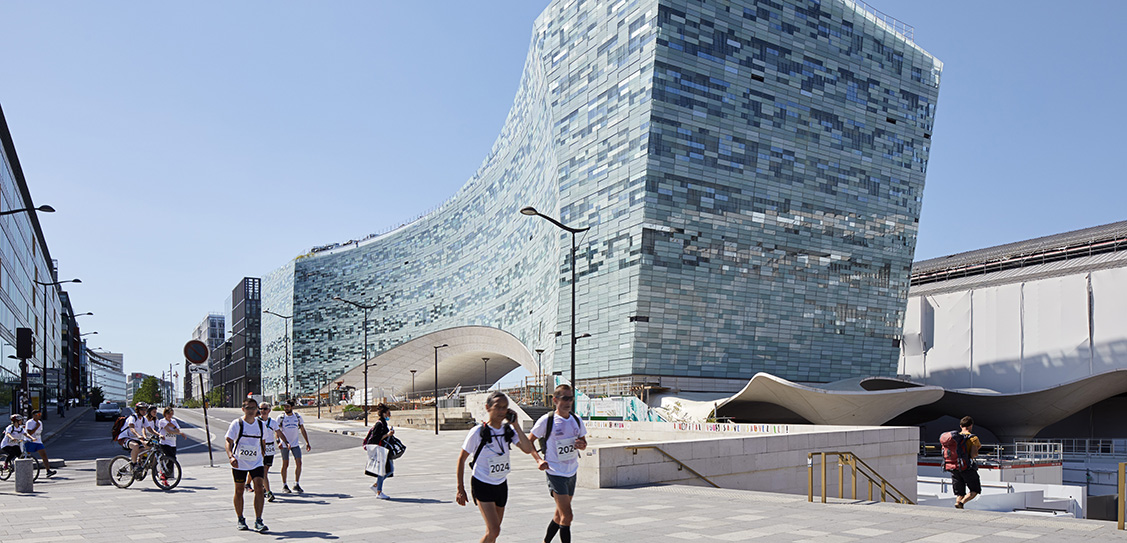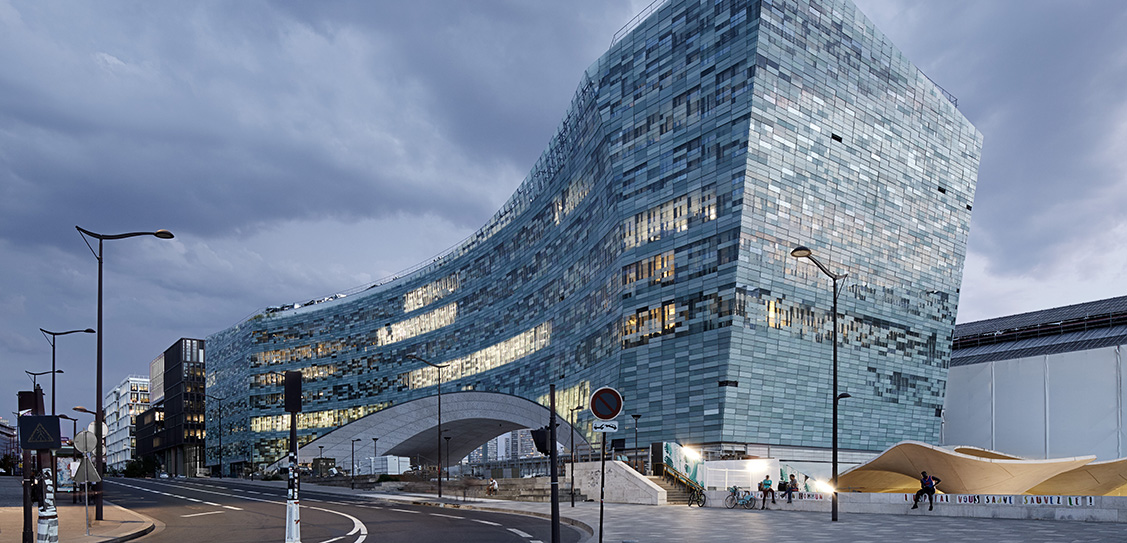With the completion of its new headquarters, the 1,600 employees of the Le Monde Group have been brought together under the same roof in a generously arching building on 67-69 Avenue Pierre-Mendès-France in the 13th arrondissement of Paris.
The Le Monde Group comprises some of France’s most famous publications, including Le Monde, Courrier International, Télérama, La Vie, and HuffPost, and their new home unites them under a shared roof together with the publication l’Obs, which is also owned by the group’s shareholders. Previously scattered across different sites in Paris, the six newsrooms now share a common home on the Rive Gauche of Paris, all while remaining independent and retaining their own space in the building.
The project represents Le Monde Group’s re-investment in its staff at a time where other media outlets experience a down-sizing of their newsrooms, and their deep commitment to cultivating a vibrant public realm through democratic access to information and physical space. A translucent, dynamic façade and expansive public plaza express the building’s openness to its surrounding context.
Indeed, the project itself emerged from a moment when these priorities were called into question. As the Le Monde Group deliberated over architectural proposals for their future home in early 2015, just days after the attacks on Charlie Hebdo Magazine’s headquarters, they ultimately selected Snøhetta and local partner SRA’s design, opting for a building that remains in open dialogue with the city of Paris and its inhabitants.
Since its inception the Le Monde Group Headquarters has embodied an architectural and symbolic counterpoint to the many challenges our societies face today. The building is primarily about opening up in a time where fear and uncertainty pushes our societies to increase barriers and strengthen security enforcement. In this sense, the project invites us to reflect on how architecture can create spaces that can be both public and private, exterior and interior, transparent or opaque. Like so many other of our projects, it is a hybrid building that explores the interstices of architecture and that is conceived to be at the service of the public.
Sitting adjacent to the historic Gare d’Austerlitz train station, the project is a close neighbour to the historic Latin Quarter and the lushly planted gardens of the Jardin des Plantes. The concave form of the building bridges over the below-grade railyard, anchored on both sides with two seven-story cantilevering volumes held together by a complex network of steel. Three gestural ‘cuts’ shape the building mass, the ‘sky cut’ reveals the oblique surface of the solar-panel-clad roof; the «city cut» pulls the building back from the along its street-facing facade; and the ‘ground cut’ carves out the underside of the bridging structure, enveloping the new public plaza together beneath its expansive arched form.
The 23,000 sq m Le Monde Group Headquarters is built at the intersection of the old, historic parts of the French capital, and the more modern districts on the Rive Gauche. A previously industrialised area with railway tracks, the district has experienced a mass development since the beginning of the 90’s under one of the most comprehensive urban developments of the French capital since 18th century Haussmannisation. Today, the district has continued to develop as a high-density commercial and business district.
The building’s pixelated outer skin is composed of more than 20,000 pixelated glass elements in a strictly organised pattern with 772 possible configurations, that give the building a sheer appearance that shifts with the changing weather and light conditions. Each glass element represents one distinct pixel classified on an opacity scale ranging from transparent to fully opaque depending on its placement, allowing for the best views from the building as well as a maximum of daylight penetration. This highly sophisticated pattern references the printed letters of newspapers and magazines and makes up a text-like pattern that can be read more clearly when the 10,000 sq m facade is seen from afar.
Spanning 80 m from one side to another, the building is a response to the conditions and challenges of the site: Acquired by the Le Monde Group in 2014, the site is situated just above the railways and platforms of the Gare d’Austerlitz which makes the creation of a technical basement impossible. The first challenge, therefore, was to construct a building where the entire technical system of the building would be cleverly incorporated into the structure of the building itself. The second challenge was that the site could only carry a specific amount of weight, and only on the two extremities of the site. As the middle section was not planned to hold the weight of a building, the client’s initial brief was to create two buildings on the parts of the site that were buildable.
Snøhetta and SRA’s response to these challenges was to work on the idea of merging the two units together through a bridging structure of steel that would literally leapfrog from one side of the site to the other: a highly demanding engineering task for a building that weighs more than the Eiffel Tower. Nonetheless, it was a necessary one, only a unified building would create the dynamic environment needed to unite the different magazine and newspaper titles of the Le Monde Group.
The journey through the Le Monde Group Headquarters commences at ground level where visitors are greeted by a broad public plaza with integrated vegetation. The plaza invites passersby to linger and interact while also creating connections to the cityscape on each side of the building. From 2021, this physical connection will be further enhanced with the introduction of a new bridge that will span across the neighbouring railways of the Gare d’Austerlitz.
New retail spaces also help activate a dynamic public realm. Situated below the warmly lit arch of the building, custom designed concrete benches offer refuge from the activity of the busy surrounding area. The site further encourages diverse transit modes and greener mobility alternatives with more than 300 bicycle parking slots and through its immediate proximity to neighbouring train stations.
The materiality of the plaza is predominated by concrete with clear references to the urban context of the building. The concrete environment creates a sense of continuity and consistency, as if parts of the ground were gently peeled back and fused into the arching roof soaring above the plaza. Cast in in-situ concrete, the arch above the plaza is carefully hand-treated to create a textured finish.
The concrete plaza and elements from the façade continue inside the building. The building’s wayfinding, which is also developed by Snøhetta, is inspired by the glazed facade of the building and adorned with classic typewriter typography. This custom wayfinding guides visitors and staff effortlessly through the building.
Two large amphitheatre stairs in each entry lead up to the third level of the building, providing an informal meeting space for staff and visitors. The stairs mark a physical continuity with the building’s arching middle-section, as if the stairs were mounted on top of it. The stairs provide access to the auditorium through an open reception area, well-suited for either conferences or receptions. The floor also comprises a staff cafeteria and restaurant including back office functions and meeting rooms.
From the third to the eighth floors, the building offers high-quality, expansive open office spaces with a ceiling-integrated heating, ventilation and lighting system assuring the building offers maximum layout flexibility. With its floor-to-ceiling windows, and views overlooking the Seine and the surrounding city of Paris, the offices offer a bright and spacious backdrop for the thousands of employees and journalists of the Le Monde Group. Floors second also feature amenities such as a library, a staff restaurant and an analogue archive dedicated to the Le Monde Group.
From the fifth to the sixth floor, one finds the office spaces dedicated to the Le Monde newsgroup. Just like the office floors below, the Le Monde offices are organised as an open space, while also offering a diversity of flexible workspaces that integrate more than 100 private work areas and over forty meeting rooms for group collaboration. The floors are connected by a double-spiraling staircase that opens the central part of the two levels. The staircase ties the newsroom together, breaking down artificial collaboration barriers and securing that information may be shared easily across the entire newsroom.
Finally, the top level of the building leads out to an open-air terrace which is accessible from both sides of the building. Framed by vegetation, the terrace creates beautiful views overlooking the surrounding cityscape and the Seine.



